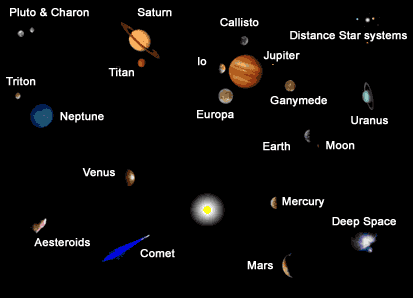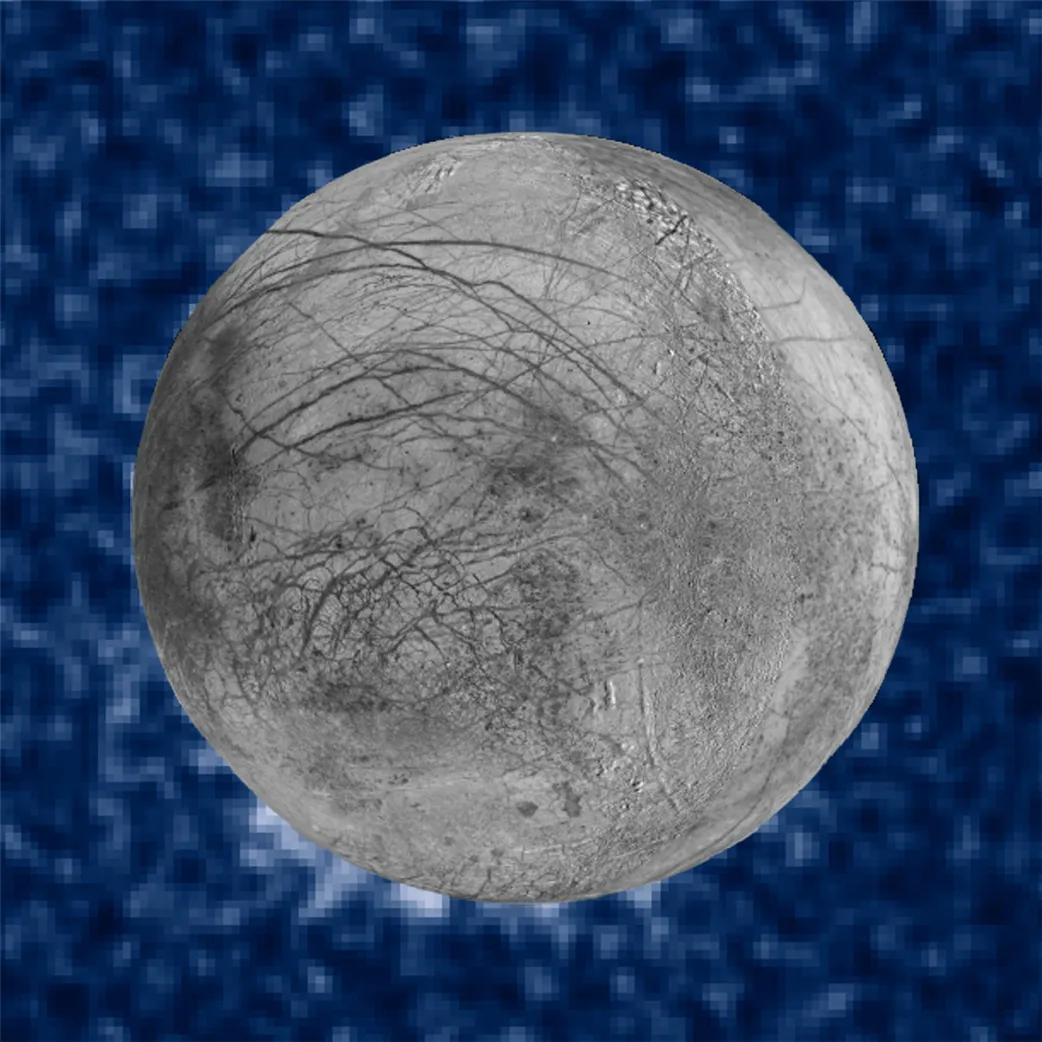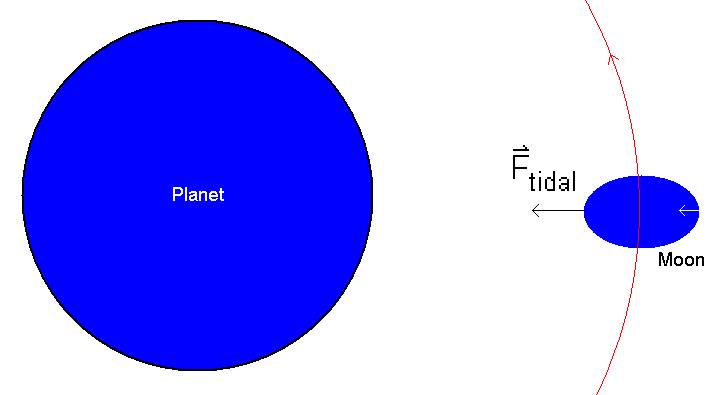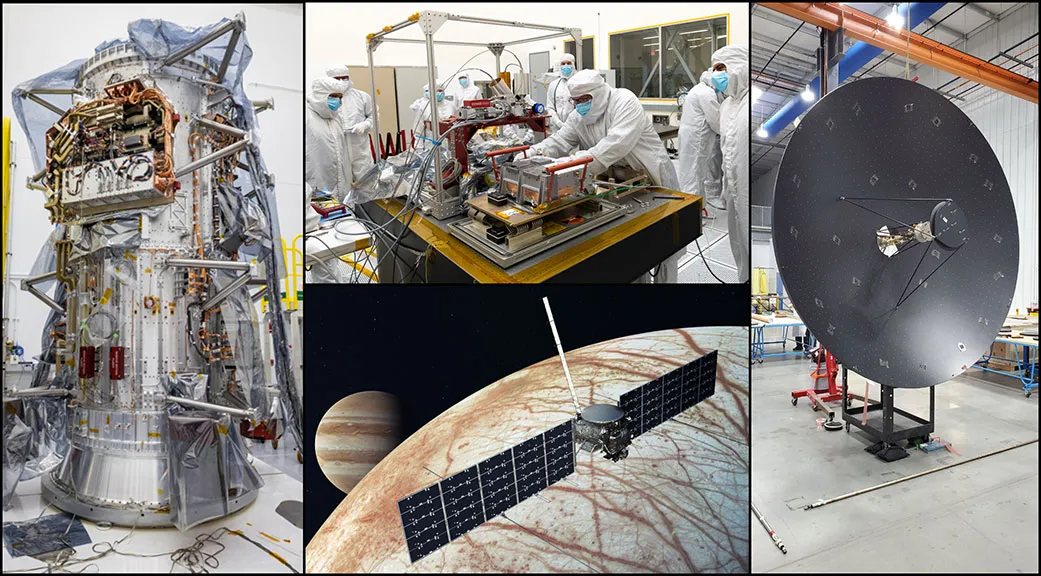(Are There Two Habitable Zones in Planetary Systems?) |

|
(Are There Two Habitable Zones in Planetary Systems?) |

|
But now, some of the places that were previously considered the least likely to hold life have turned out to be perhaps some of the most likely to provide habitable environments. Moons that were thought be cold and frozen for eons are now known to be geologically active, in surprising ways. One of them is the most volcanically active place known in the solar system. At least two others appear to have oceans of liquid water beneath their surfaces. That's right, oceans. And geysers. On the surface, they are ice worlds, but below, they are water worlds. Then there's the one with rain, rivers, lakes and seas, but made of liquid methane instead of water. Billions of kilometres farther out from the Sun than the Earth. Who would have thought? Let's look at those last three in a bit more detail
Ever since the film 2001: A Space Odyssey first came out, Europa has been the subject of fascination. A small, icy moon orbiting Jupiter, its depiction in that movie, as an inhabited world beneath its ice crust was like a sort of foreshadowing, before the Voyager and Galileo spacecraft gave us our first real close-up looks of this intriguing place.Europa is a largish moon, 3100 km is diameter nearly 90 % the size of our Moon. Europa, unlike our Moon, is covered by a surface shell of ice 15 to 25 km in thickness, covered by long cracks and fissures giving it the appearance much like that of ice floes at the poles on Earth. The surface is very young, but more surprising was the discovery that, also like on Earth, this ice cover most likely is floating on top of a deep layer of liquid water of depth 60 to 150 kilometers. The average depth of the Earth's oceans is around 3.7 kilometers. In Europa's case though, the water layer appears to cover the entire moon, a global subsurface ocean. Additionally, the Hubble telescope detected what appear to be plumes rising from the surface of Europa. 
How are these things possible?
Because there are liquid oceans on Europa, there must be a source of heat (or high concentrations of salts or ammonia) to keep Europa's water liquid. Europa is too far from the Sun for Solar heating to work, it is too small for it to retain heat from its formation for 4.6 billion years, and too small to contain enough radioactive elements to keep its interior warm. Gravitational tugging from Jupiter appears to provide enough heat to keep the water liquid instead of frozen (see next panel). The subsurface environment of Europa is thought to be similar to ocean bottoms on Earth. No sunlight, but volcanic vents generating heat and minerals. Such spots could be ideal for at least simple forms of life. Places such as these deep in the oceans on Earth are brimming with organisms which don't require sunlight to survive. | 
|
Gravitational tugging from Jupiter provides enough heat to Europa's interior. As Europa orbits Jupiter it experiences tidal forces, like the tides caused by the Moon in our oceans. Tidal forces flex and stretch Europa because its orbit is elliptical in shape. The tide is higher when Europa is close to Jupiter than when it is farther. The flexing heats Europa making Europa's interior warmer than it would be from the Sun's heat alone. Flexing might also produce volcanic activity from the rocky interior as on the neighboring moon Io. The tidal forces also cause Europa's icy outer shell to flex likely causing the cracking seen in Europa's surface.In the movie Europa is seen in a cutaway view through two cycles of its 3.5 day orbit about the giant planet Jupiter. Like Earth, Europa is thought to have an iron core, a rocky mantle and a surface ocean of salty water. Unlike on Earth, however, this ocean is deep enough to cover the whole moon, and being far from the sun, the ocean surface is globally frozen over. Europa's orbit is eccentric, which means as it travels around Jupiter, large tides, raised by Jupiter, rise and fall. Jupiter's position relative to Europa is also seen to librate, or wobble, with the same period. This tidal kneading causes frictional heating within Europa, much in the same way a paper clip bent back and forth can get hot to the touch, as illustrated by the red glow in the interior of Europa's rocky mantle and in the lower, warmer part of its ice shell. This tidal heating is what keeps Europa's ocean liquid and could prove critical to the survival of simple organisms within the ocean, if they exist. The giant planet Jupiter is now shown to be rotating from west to east, though more slowly than its actual rate. |

|
In the fall of this year, October 2024, the Europa Clipper

will be launched for Jupiter.
|

|
| |||
|
|||
Appearance-wise, the surface and geology look amazingly Earth-like, but the conditions are uniquely Titan. For that reason, it has long been considered that the chances of any kind of life existing here are remote at best. | |||
| |||
Is There Evidence for Life on Titan?In the last ten years, scientists have started to consider the possibility of life forming in Titan-like environments using liquids other than water, such as methane. Could life occur in a liquid methane lake or sea? How would it differ from water-based life? A discovery was made by Cassini/Huygens which could be interpreted as evidence of methane-based life on Titan. There was a seeming disappearance of hydrogen from Titan's atmosphere near its surface and a lack of acetylene on the surface of Titan. Previous theoretical studies suggested that those two circumstances, if ever found, could be evidence for methane-based lifeforms; lifeforms that consumed hydrogen and acetylene rather than oxygen. This is highly speculative; a chemical explanation is probably more likely according to the scientists involved, however, biology cannot be ruled out. Future proposed missions for Titan include a floating probe to land in one of the lakes and a balloon to soar over the landscape, pursuing such mysteries as never before. How cool is that? Comments by Chris McKay on the Cassini/Huygens results. |
Is Life Forming on Titan?A team of investigators led by University of Arizona graduate student Sarah Horst has approximated, in a French lab, atmospheric conditions on Saturn's moon Titan. Through a series of experiments, they bombarded the gases with radiation, producing a number of compounds, including amino acids.
Horst and the other researchers supplied radiation powerful enough to break the triple bond between the two nitrogen atoms that comprise nitrogen gas a known constituent of Titan's atmosphere. which freed the nitrogen atoms to bond with other nearby atoms, including carbons. What was in the resulting concoction? Assuming there are at least three or four structural variations of each, we are talking up to 20,000 molecules that could be in there, including a handful of some of the smallest chemical units found in cells, according to University of Arizona information. |